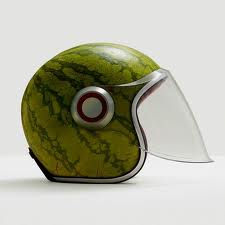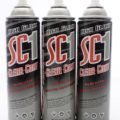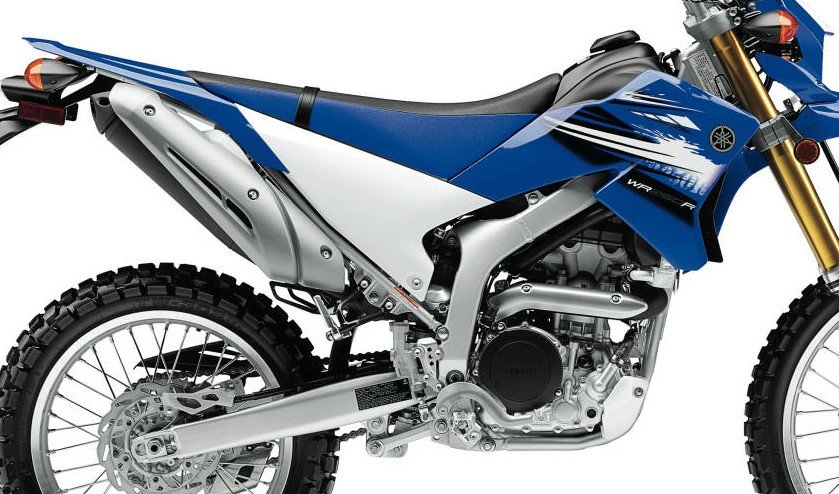 CONTRIBUTING WRITER – FRANK MORTON
Dual Sport Alchemy’s favorite unemployed, overly-caffeinated backyard engineer is at it again – determined to conjure every last bit of performance out of his 2012 Yamaha WR250R. This episode finds the aspiring alchemist with an altruistic attitude attempting a hysterectomy on his WR’s exhaust pipe! WARNING: The following article contains graphic images of lacerated and severed motorcycle components. Viewer discretion is advised.
When I wrote the review for my 2012 Yamaha WR250R my final comment was, “Next stop on the WR250R upgrade train is FMF Q4 pipe with a mega-bomb header, then Thumper Racing’s 285 big bore kit. I’ll let you know how that goes.”
Well, that train got derailed along the way, and I tried a different approach: I modified the existing exhaust system, and left the big bore kit at the station. Why? Well, the cheapest I could find a full FMF exhaust system was $390. Being a tight-ass of sorts, I just couldn’t let go of the money for that.
However, I did manage to convince my wife that I was going to get hurt really badly if I didn’t get a steering stabilizer ASAP. She bought it (literally) and now I have a new GPR system mounted on my WR. But I digress…
I’ve read numerous postings on various sites from guys who have attempted to gut their exhaust systems, but have yet to hear if it actually made a difference. I suppose that it’s a hard call to make unless you have a place to make timed runs or access to a dynamometer. We all have our “butt dynos” for reference, but so far every butt dyno I’ve seen is lacking in accuracy, not to mention visual appeal. So how would I know if any exhaust modifications could be beneficial?
Well, in theory, if I’m successful in increasing the air flow through my engine, my mixture should lean out. That being the case, I could then richen the fuel mixture through the previously installed Power Commander III. Increased air and fuel into an engine should equal an increase in power. For a true acid test I used some discreetly run drag races on a flat stretch of asphalt with the editor of this site, with whom I have lost many a race.
CONTRIBUTING WRITER – FRANK MORTON
Dual Sport Alchemy’s favorite unemployed, overly-caffeinated backyard engineer is at it again – determined to conjure every last bit of performance out of his 2012 Yamaha WR250R. This episode finds the aspiring alchemist with an altruistic attitude attempting a hysterectomy on his WR’s exhaust pipe! WARNING: The following article contains graphic images of lacerated and severed motorcycle components. Viewer discretion is advised.
When I wrote the review for my 2012 Yamaha WR250R my final comment was, “Next stop on the WR250R upgrade train is FMF Q4 pipe with a mega-bomb header, then Thumper Racing’s 285 big bore kit. I’ll let you know how that goes.”
Well, that train got derailed along the way, and I tried a different approach: I modified the existing exhaust system, and left the big bore kit at the station. Why? Well, the cheapest I could find a full FMF exhaust system was $390. Being a tight-ass of sorts, I just couldn’t let go of the money for that.
However, I did manage to convince my wife that I was going to get hurt really badly if I didn’t get a steering stabilizer ASAP. She bought it (literally) and now I have a new GPR system mounted on my WR. But I digress…
I’ve read numerous postings on various sites from guys who have attempted to gut their exhaust systems, but have yet to hear if it actually made a difference. I suppose that it’s a hard call to make unless you have a place to make timed runs or access to a dynamometer. We all have our “butt dynos” for reference, but so far every butt dyno I’ve seen is lacking in accuracy, not to mention visual appeal. So how would I know if any exhaust modifications could be beneficial?
Well, in theory, if I’m successful in increasing the air flow through my engine, my mixture should lean out. That being the case, I could then richen the fuel mixture through the previously installed Power Commander III. Increased air and fuel into an engine should equal an increase in power. For a true acid test I used some discreetly run drag races on a flat stretch of asphalt with the editor of this site, with whom I have lost many a race.
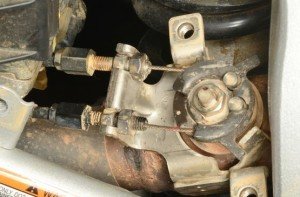 I began my exhaust modification by disconnecting the cables that operate the EXUP system just in front of the muffler. Having done that, I simply removed the muffler from the header pipe and the mounting on the bike. Pictured right is what’s left over. Surprisingly, this unit is much lighter than I anticipated, which made me wonder just how much weight savings the FMF system would have to offer.
I began my exhaust modification by disconnecting the cables that operate the EXUP system just in front of the muffler. Having done that, I simply removed the muffler from the header pipe and the mounting on the bike. Pictured right is what’s left over. Surprisingly, this unit is much lighter than I anticipated, which made me wonder just how much weight savings the FMF system would have to offer.
 In this picture (poor as the quality is), you can see where the EXUP system (nothing more that a large butterfly valve within the pipe) is, and where the catalytic converter is located. You can also see where I elected to make my cut to access the cat, but you could as easily cut further forward for easier access to the cat. Notice that the cat is a little deep from where I cut, but still easily removed.
In this picture (poor as the quality is), you can see where the EXUP system (nothing more that a large butterfly valve within the pipe) is, and where the catalytic converter is located. You can also see where I elected to make my cut to access the cat, but you could as easily cut further forward for easier access to the cat. Notice that the cat is a little deep from where I cut, but still easily removed.
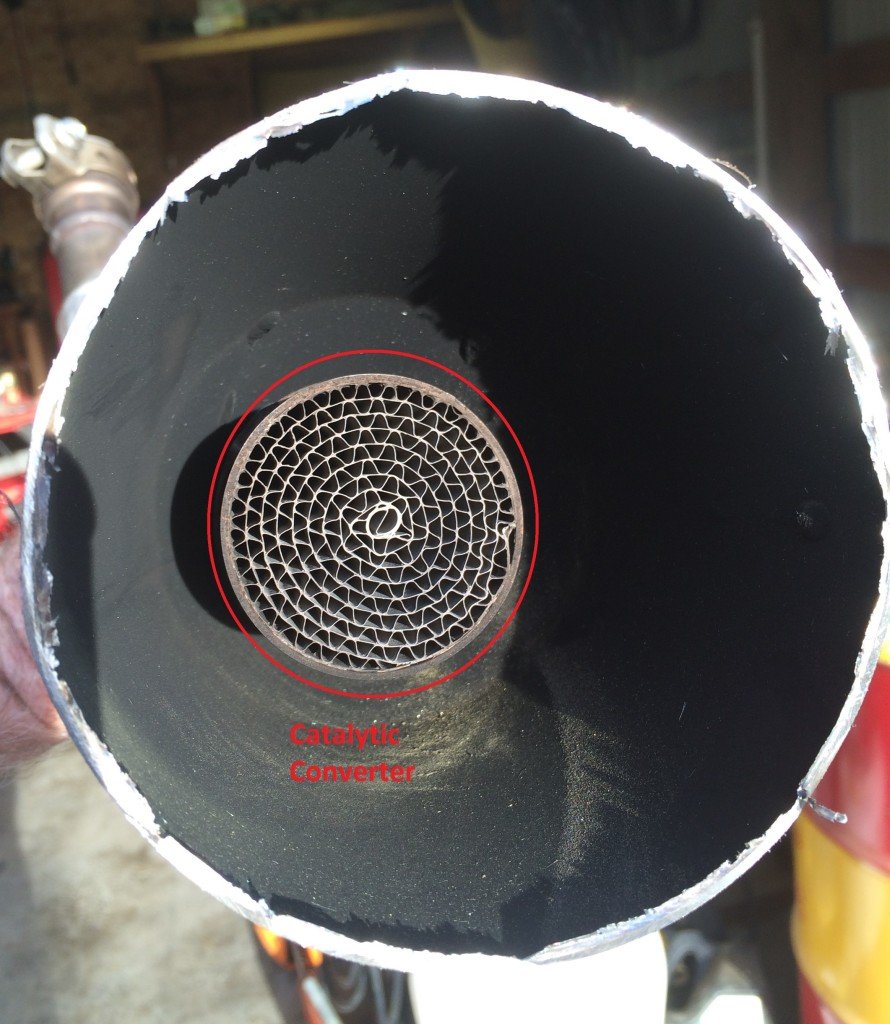 To remove this one, I simply chiseled the guts out of it. Had I cut lower, I could have cut the entire unit out: 6 of one, half a dozen of the other. The end result looked like this:
To remove this one, I simply chiseled the guts out of it. Had I cut lower, I could have cut the entire unit out: 6 of one, half a dozen of the other. The end result looked like this: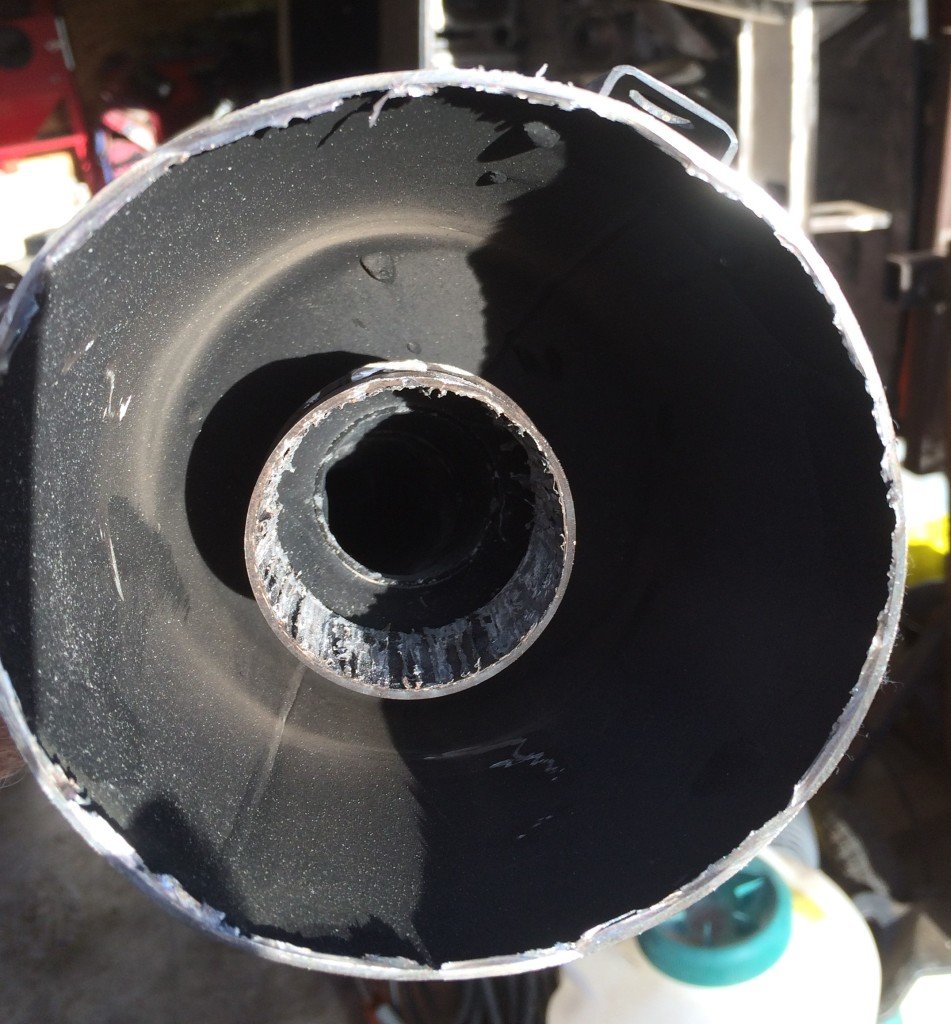 I should caution you here that you might want to mark the muffler prior to cutting it so that you can realign it when welding the two halves back together. If you don’t mark it first, you’ll have to remount the pieces to the bike for proper alignment.
Now moving on to the EXUP. First step is to cut or grind the cable mounts off the pipe.
I should caution you here that you might want to mark the muffler prior to cutting it so that you can realign it when welding the two halves back together. If you don’t mark it first, you’ll have to remount the pieces to the bike for proper alignment.
Now moving on to the EXUP. First step is to cut or grind the cable mounts off the pipe.
 Next, cut or grind off the “bungs” that the butterfly valve mounts to.
Next, cut or grind off the “bungs” that the butterfly valve mounts to.
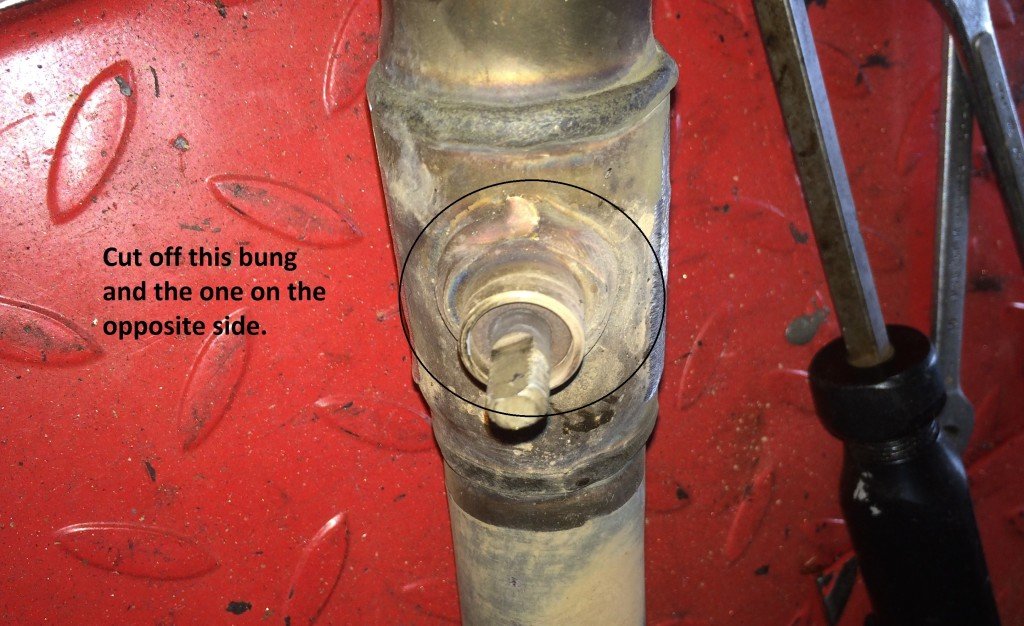 After removing both bungs, I slit my pipe half way through, and fished the butterfly valve out through the slit. This seemed the cleanest way to do it, and left less of a hack job to repair than some of the other modifications I’ve seen.
After removing both bungs, I slit my pipe half way through, and fished the butterfly valve out through the slit. This seemed the cleanest way to do it, and left less of a hack job to repair than some of the other modifications I’ve seen.
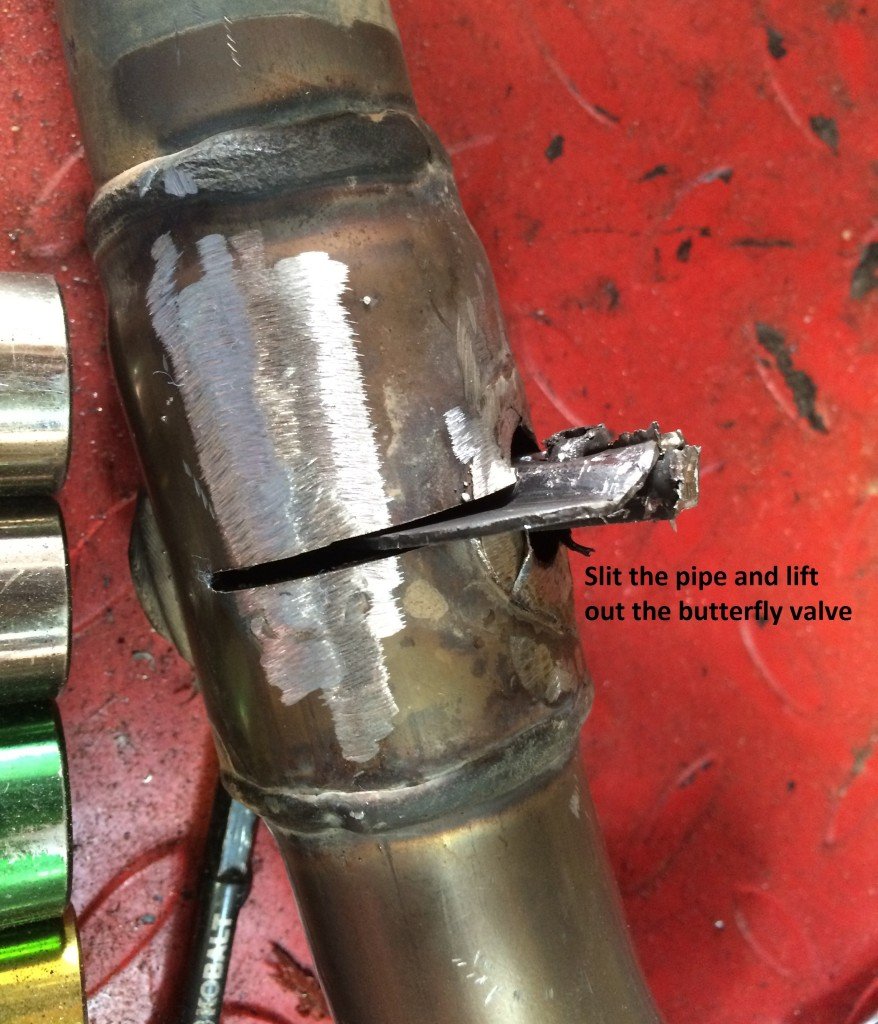 If you look closely at the left side of this pipe, you’ll notice that I didn’t remove all the bung, not like the right side. What you see there is brass, and it can’t be TIG welded. Make certain you get all of it to make a cleaner, easier job. Now simply weld up the two holes and the slit, and you have one clean pipe.
If you look closely at the left side of this pipe, you’ll notice that I didn’t remove all the bung, not like the right side. What you see there is brass, and it can’t be TIG welded. Make certain you get all of it to make a cleaner, easier job. Now simply weld up the two holes and the slit, and you have one clean pipe.
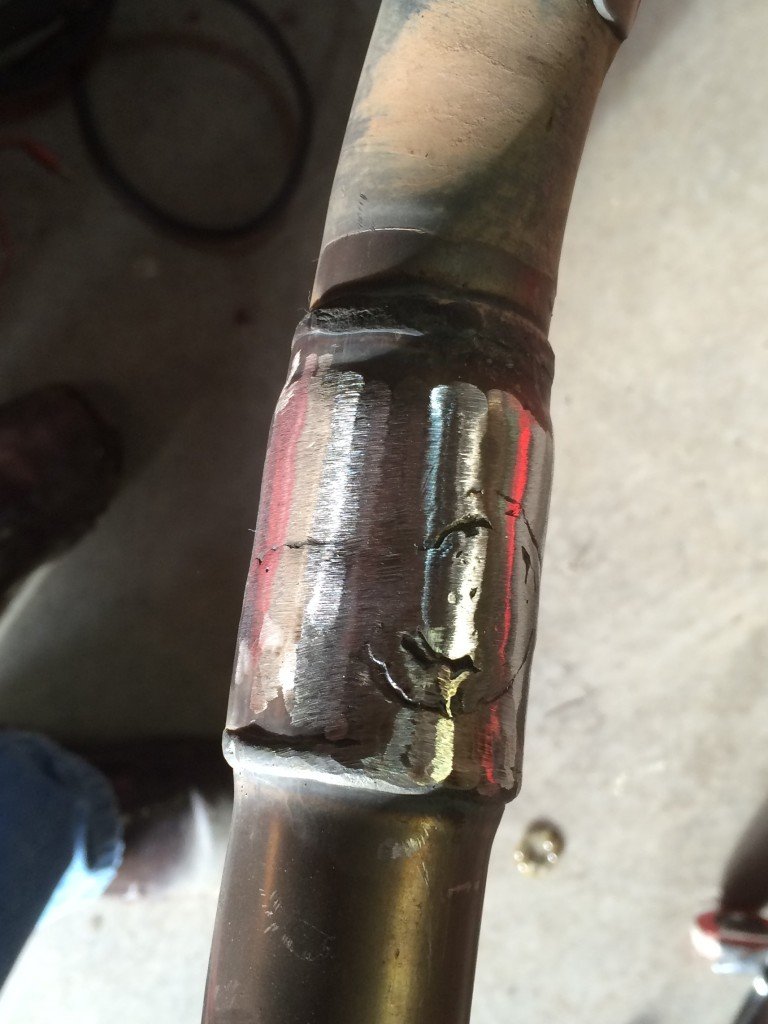 The last step in this modification is to remove the EXUP actuator on the left side of the bike, just below the battery. It’s only held on by two bolts and one electrical connector. Notice that the lower battery mount is part of this, so the two 6mm hex bolts will have to be reinserted.
The last step in this modification is to remove the EXUP actuator on the left side of the bike, just below the battery. It’s only held on by two bolts and one electrical connector. Notice that the lower battery mount is part of this, so the two 6mm hex bolts will have to be reinserted.
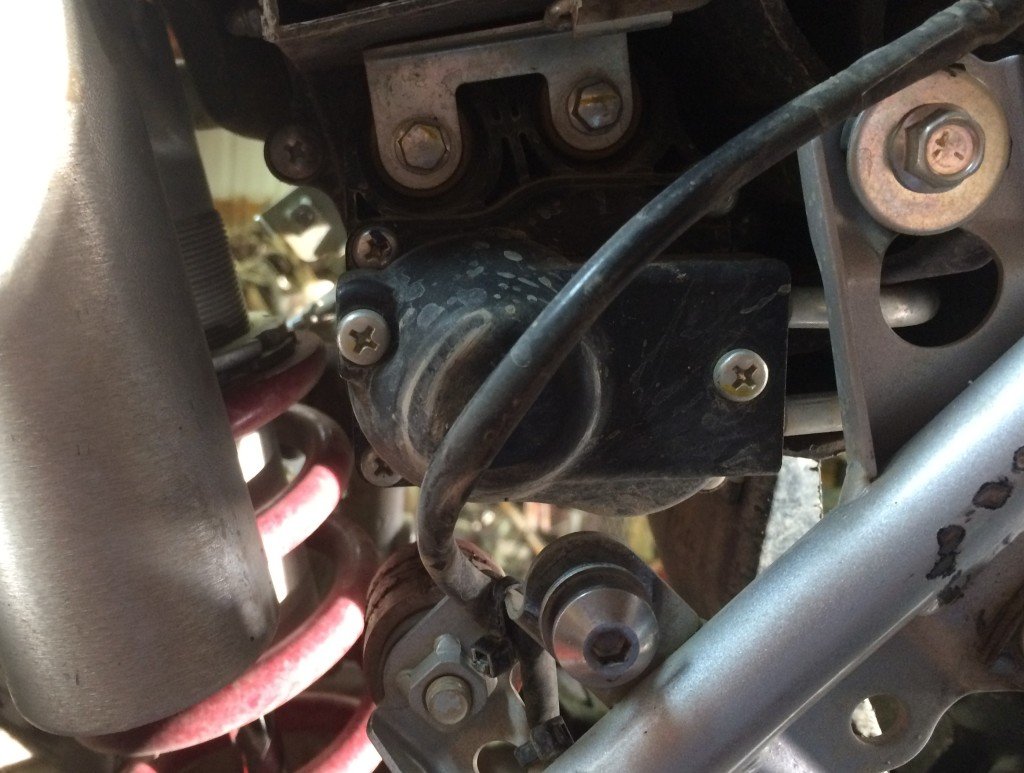 Unplug the unit and install an EXUP emulator into the empty socket. I got mine from 12 O’clock Labs for $50. Yeah, I know, I hated to let go of fifty bucks, which could buy a lot of coffee, but I justified the expense by realizing that if I were disappointed with my mods, I would have to get one for the FMF pipe anyway.
Unplug the unit and install an EXUP emulator into the empty socket. I got mine from 12 O’clock Labs for $50. Yeah, I know, I hated to let go of fifty bucks, which could buy a lot of coffee, but I justified the expense by realizing that if I were disappointed with my mods, I would have to get one for the FMF pipe anyway.
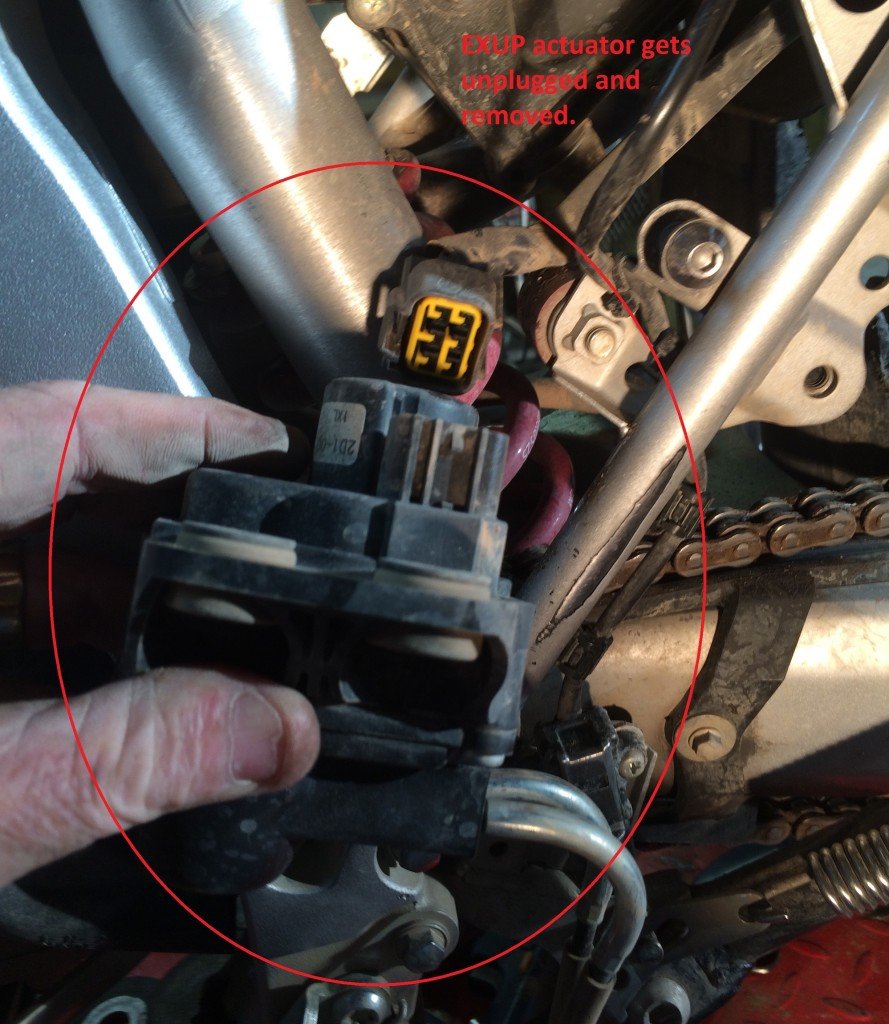 Below photograph is the emulator plugged in. My understanding is that the bikes computer will throw an error code if this isn’t installed. And I wasn’t willing to try starting the bike without one.
Below photograph is the emulator plugged in. My understanding is that the bikes computer will throw an error code if this isn’t installed. And I wasn’t willing to try starting the bike without one.
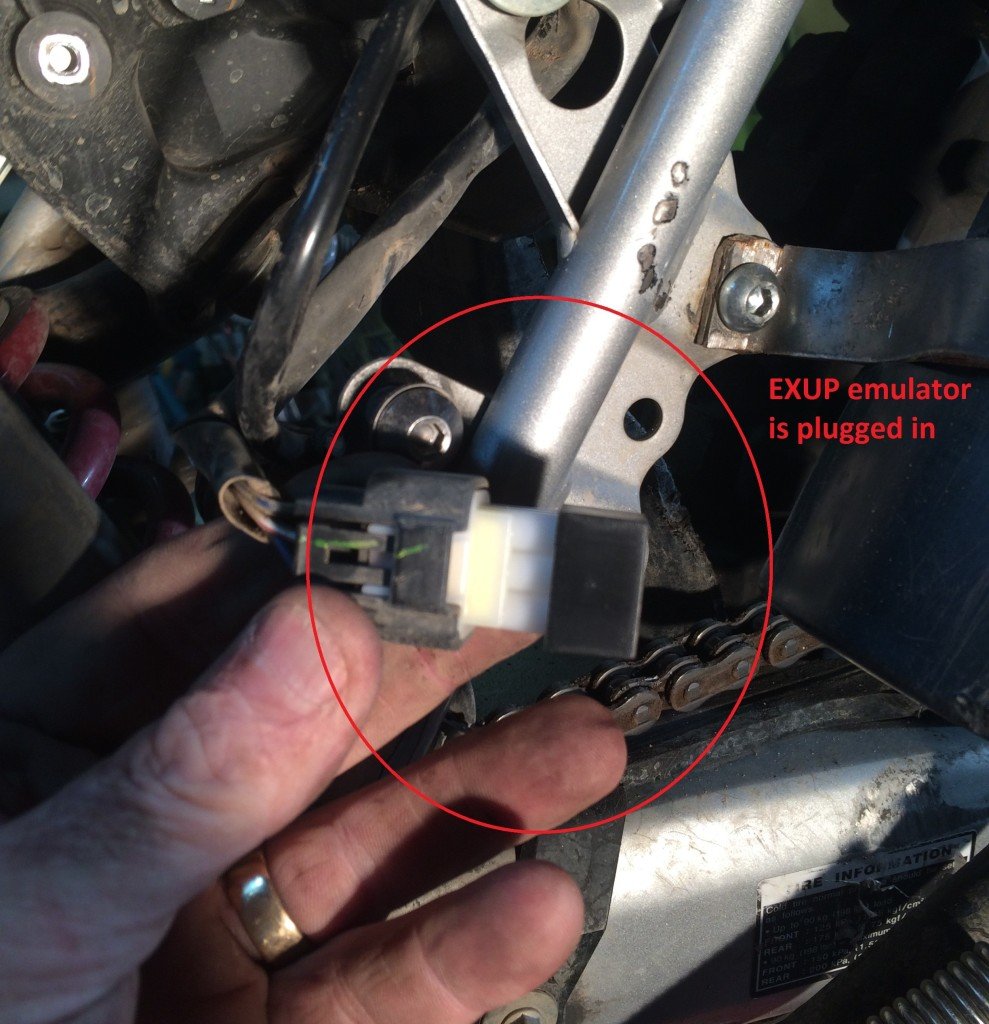 So, how’d all this turn out? Well, the bike fired right up, but had a hesitation when the throttle was twisted quickly. I let the bike warm up a bit and took it out into a dry dirt lot. When I hammered the throttle from idle in 1st gear, I felt the front wheel lift ever so slightly, the engine hesitated, set the wheel down then took off nicely. This repeated itself several times, so I decided to play with the fuel/air mixture.
As I had hoped, richening the mixture by 30% on the lower rpm range solved the hesitation, and when I hit the throttle, the bike stood up on its rear tire. I was absolutely amazed.
Since completing this modification, I’ve only had one opportunity to take the bike out in the dirt, and that was a ride with this site’s editor. While a nagging injury didn’t allow for a very aggressive ride, there is no question in my mind that there’s a perceptible increase in power and throttle “crispness”. What I’m going to do here is ask the editor to chime in on his thoughts based on this last ride. Seems fair to get it from an unbiased party.
(Editor’s note: while Frank was the same – salty, surly, and slightly smelly, his bike was definitely improved and empowered. Not only did his WR250R keep pace on a two-track long uphill grade with my more masculine 400 cc power plant, it stayed much lower in the RPMs than in previous similar conditions, making it sound like an actual motorcycle instead of a wound up lawn & leaf blower.)
The bottom line is that I am extremely pleased with the results. Don’t get me wrong, I don’t believe for a second that this exhaust mod is responsible for all the power increase. It’s clearly a cumulative result of all the modifications to the powertrain: opening the air box, adding the Power Commander, gutting the exhaust and expanding the exhaust tip. If I were to buy another WR, I would not hesitate to make these same mods to it immediately. Nor would I hesitate to recommend them to any WR250R owner.
Oh, and about that drag race. I still got my ass beat, but not as badly as before. But in all fairness, I missed 3rd gear, had sand in my eyes, and my butt dyno was plugged.
So, how’d all this turn out? Well, the bike fired right up, but had a hesitation when the throttle was twisted quickly. I let the bike warm up a bit and took it out into a dry dirt lot. When I hammered the throttle from idle in 1st gear, I felt the front wheel lift ever so slightly, the engine hesitated, set the wheel down then took off nicely. This repeated itself several times, so I decided to play with the fuel/air mixture.
As I had hoped, richening the mixture by 30% on the lower rpm range solved the hesitation, and when I hit the throttle, the bike stood up on its rear tire. I was absolutely amazed.
Since completing this modification, I’ve only had one opportunity to take the bike out in the dirt, and that was a ride with this site’s editor. While a nagging injury didn’t allow for a very aggressive ride, there is no question in my mind that there’s a perceptible increase in power and throttle “crispness”. What I’m going to do here is ask the editor to chime in on his thoughts based on this last ride. Seems fair to get it from an unbiased party.
(Editor’s note: while Frank was the same – salty, surly, and slightly smelly, his bike was definitely improved and empowered. Not only did his WR250R keep pace on a two-track long uphill grade with my more masculine 400 cc power plant, it stayed much lower in the RPMs than in previous similar conditions, making it sound like an actual motorcycle instead of a wound up lawn & leaf blower.)
The bottom line is that I am extremely pleased with the results. Don’t get me wrong, I don’t believe for a second that this exhaust mod is responsible for all the power increase. It’s clearly a cumulative result of all the modifications to the powertrain: opening the air box, adding the Power Commander, gutting the exhaust and expanding the exhaust tip. If I were to buy another WR, I would not hesitate to make these same mods to it immediately. Nor would I hesitate to recommend them to any WR250R owner.
Oh, and about that drag race. I still got my ass beat, but not as badly as before. But in all fairness, I missed 3rd gear, had sand in my eyes, and my butt dyno was plugged.
 About the Author: Frank Morton might have had a short-lived career as a Sensitivity Trainer had he not decided to enlist in the Marine Corps the day after graduating High School and go to Vietnam. After his Tour of Duty he joined the Oregon State Police and spent several decades fighting crime and scraping dead people off highways. Now retired, he enjoys badger juggling, hula-hooping with Dunlop 606s, and depleting the country of its strategic reserves of coffee.
About the Author: Frank Morton might have had a short-lived career as a Sensitivity Trainer had he not decided to enlist in the Marine Corps the day after graduating High School and go to Vietnam. After his Tour of Duty he joined the Oregon State Police and spent several decades fighting crime and scraping dead people off highways. Now retired, he enjoys badger juggling, hula-hooping with Dunlop 606s, and depleting the country of its strategic reserves of coffee.

